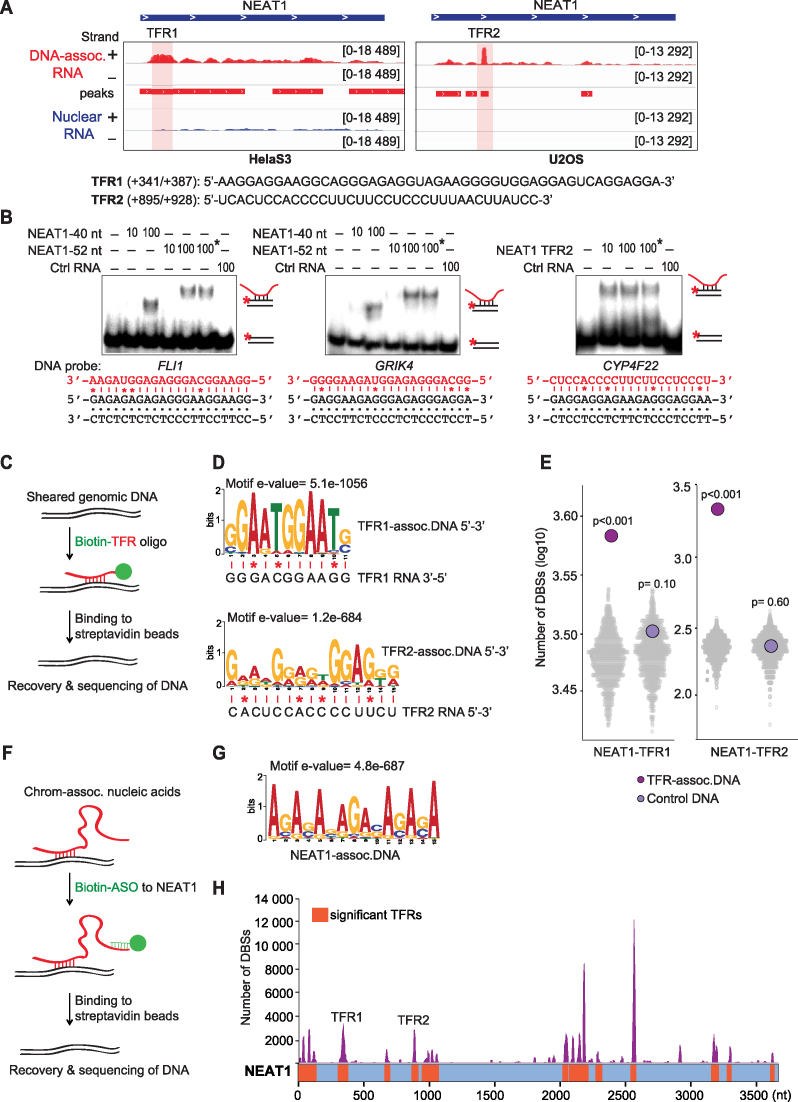Figure 5.
NEAT1 forms triplexes at numerous genomic sites. (A) NEAT1 profiles in TriplexRNA-seq (DNA-IP) (red) and nuclear RNA (blue) from HeLa S3 and U2OS cells with shaded TFR1 and TFR2. Minus (-) and plus (+) strands are shown. The position and sequence of NEAT1-TFR1 and -TFR2 are shown below. (B) EMSAs using 10 or 100 pmol of synthetic NEAT1 versions comprising TFR1 (40 or 52 nt) or TFR2 incubated with 0.25 pmol of double–stranded 32P-labeled oligonucleotides which harbor sequences of NEAT1 target genes predicted from CHART-seq (Supplementary Table S2). Reactions marked with an asterisk (*) were treated with 0.5 U RNase H. As a control, RNA without a putative TFR was used. Potential Hoogsteen base pairing between motifs and respective TFR sequences are shown; mismatches are marked (*). (C) Schematic depiction of the TFR-based capture assay. Biotinylated RNA oligos covering NEAT1-TFR1 and NEAT1-TFR2 were used to capture genomic DNA. (D) MEME motif analysis identifying consensus motifs in DNA captured by NEAT1-TFR1 (399 of top 500 peaks) and by NEAT1-TFR2 (500 of top 500 peaks ranked by peak P-value). Potential Hoogsteen base pairing between motifs and respective TFR sequences are shown; mismatches are marked (*). (E) TDF analysis of the triplex-forming potential of NEAT1-TFR1 and NEAT1-TFR2 RNAs with top 500 TFR-associated and control DNA peaks (ranked by peak P-value) compared to 500 randomized regions (N = 1000, colored grey). P-values were obtained from one-tailed Mann–Whitney test. (F) Scheme presenting antisense oligo (ASO)-based capture of NEAT1-associated DNA. (G) Consensus motif in NEAT1-associated DNA sites (314 of top 500 peaks ranked by peak P-value). (H) TDF analysis predicting the triplex-forming potential of NEAT1 on ASO-captured DNA regions. Significant TFRs along NEAT1 are shown in orange, the number of target sites (DBS) for each TFR in purple. For TFR- and ASO-based capture assays nucleic acids isolated from HeLa S3 chromatin were used.

